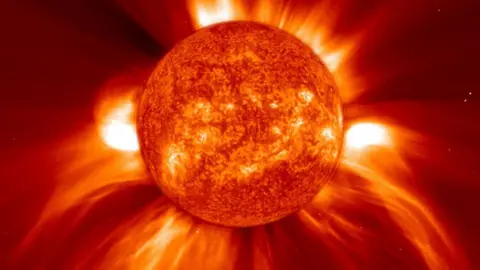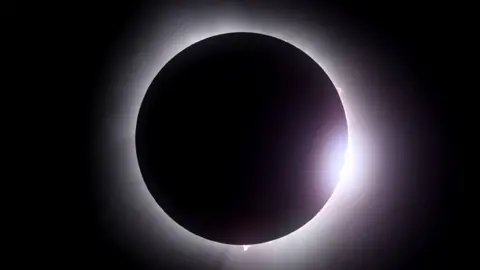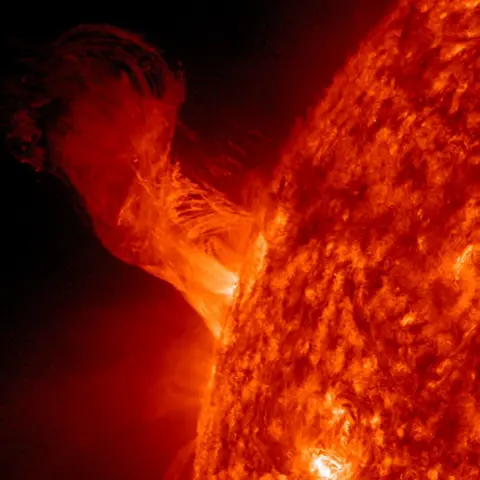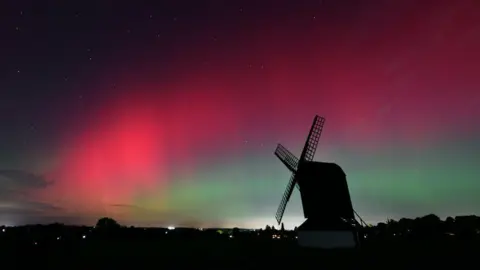Why India’s latest Sun mission finding is crucial for the world
 Getty Images
Getty ImagesScientists in India have reported the “first significant result” from Aditya-L1, the country’s first solar observation mission in space.
The new learnings, they said, could help keep power grids and communication satellites out of harm’s way the next time solar activities threatened infrastructure on Earth and space.
On 16 July, the most important of the seven scientific instruments Aditya-L1 is carrying – Visible Emission Line Coronagraph, or Velc – captured data that helped scientists estimate the precise time a coronal mass ejection (CME) began.
Studying CMEs – massive fireballs that blow out of the Sun’s outermost corona layer – is one of the most important scientific objectives of India’s maiden solar mission.
“Made up of energy particles, a CME could weigh up to a trillion kilograms and can attain a speed of up to 3,000km [1,864 miles] per second while travelling. It can head out in any direction, including towards the Earth,” says Prof R Ramesh of the Indian Institute of Astrophysics that designed Velc.
“Now imagine this huge fireball hurtling towards Earth. At its top speed, it would take just about 15 hours to cover the 150 million km Earth-Sun distance.”
The coronal ejection that Velc captured on 16 July had started at 13:08 GMT. Prof Ramesh, Velc’s Principal Investigator who has published a paper on this CME in the prestigious Astrophysical Journal Letters, said it originated on the side of the Earth.
“But within half an hour of its journey, it got deflected and went in a different direction, going behind the Sun. As it was too far away, it did not impact Earth’s weather.”
 Getty Images
Getty ImagesBut solar storms, solar flares and coronal mass ejections routinely impact Earth’s weather. They also impact the space weather where nearly 7,800 satellites, including more than 50 from India, are stationed.
According to Space.com, they rarely pose a direct threat to human life, but they can cause mayhem on Earth by interfering with the Earth’s magnetic field.
Their most benign impact is causing beautiful auroras in places close to the North and South Pole. A stronger coronal mass ejection can cause auroras to show up in skies further away such as in London or France – as it did in May and October.
But the impact is much more serious in space where the charged particles of a coronal mass ejection can make all the electronics on a satellite malfunction. They can knock down power grids and affect weather and communication satellites.
“Today our lives fully depend on communication satellites and CMEs can trip the internet, phone lines and radio communication,” Prof Ramesh says. “That can lead to absolute chaos.”
 Getty Images
Getty ImagesThe most powerful solar storm in recorded history occurred in 1859. Called the Carrington Event, it triggered intense auroral light shows and knocked out telegraph lines across the globe.
Scientists at Nasa say an equally strong storm was headed at Earth in 2012 and we had “a close shave just as perilous”. They say a powerful coronal mass ejection tore through Earth’s orbit on 23 July but that we were “incredibly fortunate” that instead of hitting our planet, the storm cloud hit Nasa’s solar observatory STEREO-A in space.
- Aditya-L1: India’s Sun mission reaches final destination
- Chandrayaan-3: India makes historic landing near Moon’s south pole
In 1989, a coronal mass ejection knocked out part of Quebec’s power grid for nine hours, leaving six million people without power.
And on 4 November 2015, solar activity disrupted air traffic control at Sweden and some other European airports, leading to travel chaos for hours.
Scientists say that if we are able to see what happens on the Sun and spot a solar storm or a coronal mass ejection in real time and watch its trajectory, it can work as a forewarning to switch off power grids and satellites and keep them out of harm’s way.
 Getty Images
Getty ImagesUS space agency Nasa, the European Space Agency (ESA), Japan and China have been watching the Sun through their space-based solar missions for decades. With Aditya-L1 – named after the Hindu god of Sun – Indian space agency Isro joined that select group earlier this year.
From its vantage point in space, Aditya-L1 is able to watch the Sun constantly, even during eclipses and occultations, and carry out scientific studies.
Prof Ramesh says when we look at the Sun from the Earth, we see an orange ball of fire which is the photosphere – the Sun’s surface or the brightest part of the star.
It’s only during a total eclipse, when the Moon passes between Earth and the Sun and covers the photosphere that we are able to see the solar corona, the Sun’s outermost layer.
- How important are India’s Moon mission findings?
- Why it costs India so little to reach the Moon and Mars
India’s coronagraph, Prof Ramesh says, has a slight advantage over the coronagraph in Nasa-ESA’s joint Solar and Heliospheric Observatory.
“Ours is of a size that it’s able to mimic the role of the Moon and artificially hide the Sun’s photosphere, providing Aditya-L1 an uninterrupted view of the corona 24 hours a day 365 days a year.”
The coronagraph on Nasa-ESA’s mission, he says, is bigger which means it hides not only the photosphere but also parts of corona – so it cannot see the genesis of a CME if it originates in the hidden region.
“But with Velc, we can precisely estimate the time a coronal mass ejection begins and in which direction it’s headed.”
India also has three ground based observatories – in Kodaikanal, Gauribidanur in the south and Udaipur in the northwest – to look at the Sun. So if we add up their findings with that of Aditya-L1, we can greatly improve our understanding of the Sun, he adds.
Follow BBC News India on Instagram, YouTube, Twitter and Facebook.





